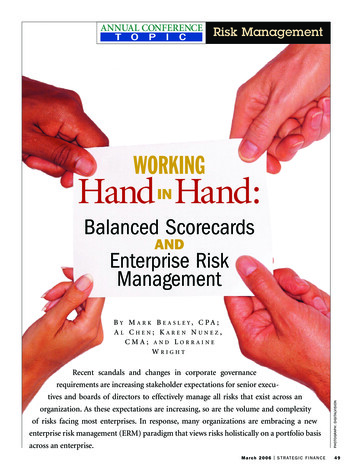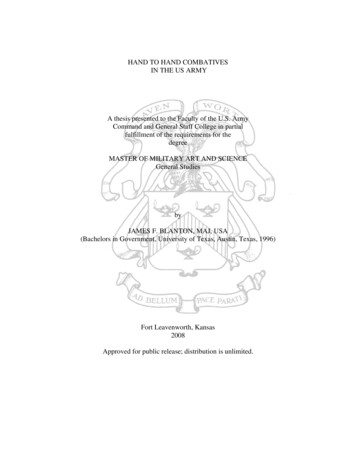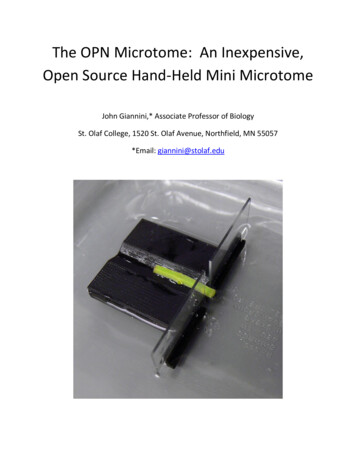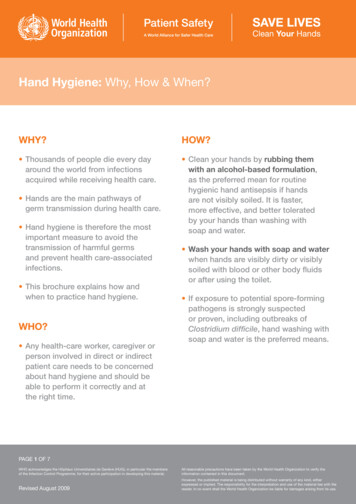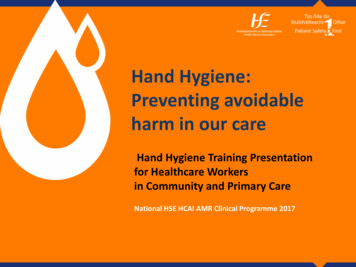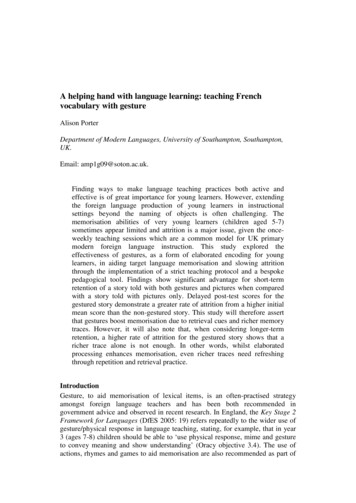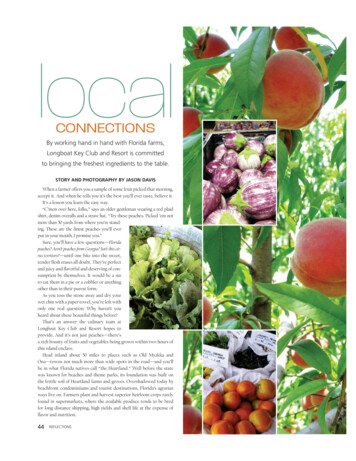
Transcription
localCONNECTIONSBy working hand in hand with Florida farms,Longboat Key Club and Resort is committedto bringing the freshest ingredients to the table.STORY AND PHOTOGRAPHY BY JASON DAVISWhen a farmer offers you a sample of some fruit picked that morning,accept it. And when he tells you it’s the best you’ll ever taste, believe it.It’s a lesson you learn the easy way.“C’mon over here, folks,” says an older gentleman wearing a red plaidshirt, denim overalls and a straw hat. “Try these peaches. Picked ’em notmore than 50 yards from where you’re standing. These are the finest peaches you’ll everput in your mouth, I promise you.”Sure, you’ll have a few questions—Floridapeaches? Aren’t peaches from Georgia? Isn’t this citrus territory?—until one bite into the sweet,tender flesh erases all doubt. They’re perfectand juicy and flavorful and deserving of consumption by themselves. It would be a sinto eat them in a pie or a cobbler or anythingother than in their purest form.As you toss the stone away and dry yourwet chin with a paper towel, you’re left withonly one real question: Why haven’t youheard about these beautiful things before?That’s an answer the culinary team atLongboat Key Club and Resort hopes toprovide. And it’s not just peaches—there’sa rich bounty of fruits and vegetables being grown within two hours ofthis island enclave.Head inland about 50 miles to places such as Old Myakka andOna—towns not much more than wide spots in the road—and you’llbe in what Florida natives call “the Heartland.” Well before the statewas known for beaches and theme parks, its foundation was built onthe fertile soil of Heartland farms and groves. Overshadowed today bybeachfront condominiums and tourist destinations, Florida’s agrarianways live on. Farmers plant and harvest superior heirloom crops rarelyfound in supermarkets, where the available produce tends to be bredfor long-distance shipping, high yields and shelf life at the expense offlavor and nutrition.44REFLECTIONS
Harvesting crops grown in Myakka Cityand east Bradenton, King Farms producesa wide array of fruits and vegetables,including succulent Florida peaches.REFLECTIONS45
Chef Ed Geyfman (above) andFood and Beverage DirectorRobert Weil (far right) frequentlystay in touch with local farmerssuch as Rick Turner (near right) ofHi-Hat Ranch and Marge Mitchellof Mitchell's Natural Produce."THIS IS WHAT THE BEST RESTAURANTS DO. NOT JUST THE BEST CLUBAND HOTEL RESTAURANTS, BUT THE BEST RESTAURANTS, PERIOD."Remember tomatoes that used to taste like tomatoes? They’re stillgrown around these parts.“We’re seeing some fantastic products that you just can’t get throughthe usual supply chain,” says Robert Weil, food and beverage director atLongboat Key Club and Resort “Baby red romaine lettuce. Inch-big blueberries. Sweet corn you can eat raw in the field. These are the things—extremely delicious, highly nutritious ingredients—that we want tobring to our members and guests.“Consumers have become much savvier about the food they consume.They’ve become more health conscious and aware of their diet, concernedabout processed foods. They want to know where things come from andhow things are prepared. That’s very important for them, which makes itvery important for us—not only because our members and guests wantit, but because it’s the right thing to offer.“This is what the best restaurants do. Not just the best club and hotelrestaurants, but the best restaurants, period.”On the belief that produce harvested at its ideal ripeness and delivered quickly to keep most of its nutritional value and flavor intact meansa better dining experience, the “locavore” movement was identified asthe most important culinary trend of 2010, according to a survey of topU.S. chefs by the National Restaurant Association. Ahead of the curve,however, Weil and his team have been working with a handful of localfarms over the past few years to bring their fragrant and flavorful products to the Club’s kitchens.Currently, about 75 percent of the menu at the Club’s flagship SandsPointe restaurant incorporates locally sourced ingredients, includingseafood and meats, during peak season. That’s far better than the indus-46REFLECTIONStry average, but there’s a desire to increase that figure. As Weil and histeam see it, an ongoing dialogue with local farmers is essential.The main challenge in obtaining great local produce has always beenavailability, and not just in the sense of physically getting the harvestfrom farm to fork. Instead, it’s been more about getting the right thingsinto the ground in the first place.“It used to be that some farmers would plant things they wanted toplant,” Weil says. “They might come to us with petite white aubergines,which is something we might very well want, but it would turn outthey’d only produced four cases. We can’t add something with a limitedsupply to the menu. If they had been planning several months ahead, wecould have worked something out.“We saw that as an opportunity to build a two-way street where theyknow what we want and plant just for us, and we know what they haveand can create a seasonally inspired menu from the local growing cycle.”It was with this philosophy that a delegation from the Club made adaylong excursion to some local farms one morning last June, a journeythat takes place several times a year. Part conversation, part appraisal,these personal visits give the Club’s culinary team a better understanding of what’s happening down on the farm—and vice versa.One important stop: visiting Marge Mitchell, who runs Mitchell’sNatural Produce with her grown children on a 10-acre farm near Ona.She produces lettuce exclusively for Longboat Key Club and Resort fromthe controlled confines of a hand-built hydroponic greenhouse, embracing all things natural. Captured rainwater is used for irrigation. Plantsare pollinated by bumblebees. Pests are controlled by ladybugs.continued on page 70
REFLECTIONS47
local connectionscontinued from page 47Mitchell proudly shows visitors a bumper crop of zephyrs, a summerhybrid of green Delicata and yellow acorn squash with a nutty flavor, ofwhich she produces about 1,700 pounds a year. She’s also happy with someMalabar spinach plantings, some lemongrass and some peppers, and talksabout the fate of some beets that didn’t work out as hoped. “This time ofyear, we just play,” says Mitchell, a retired nurse who took up farming in2005 after being inspired by a hydroponics seminar near Orlando. “We experiment with new methods all the time to see what happens. If it works,great. As a small farm, we can devote time and attention to our work.”That personal touch may be the secret to those amazing Florida peaches,an early-season variety known as Tropic Beauty that was developed over45 years by the University of Florida researchers in partnership with stategrowers. King Farms, based in Myakka City and operated by third-generation Florida farmers, grows them in an orchard at a small farm in eastBradenton and was first to bring them to market.To understand the attention that goes into every harvest, consider this:King Farms produces more than 40 varieties of heirloom tomatoes, andeach piece is hand-polished before it’s boxed for delivery. And the plumpblueberries, grown in Myakka? “They’re our pride and joy,” says ShelbyKing, who, with husband Ben, runs the farms. They were the first localsto strike a deal with Longboat Key Club and Resort to provide fruits andvegetables throughout the year. “There’s a lot we can produce on even asmall amount of acreage and supply it locally,” she says.That includes the peaches, which had overwhelmed the trees and attracted the attention of Executive Chef Ed Geyfman, who quickly beganthinking of ways to incorporate them into the club’s menus. “When thepeaches come around,” he asks, “they’re all ours, right?”Weil prefers to look at the bigger picture. Not only does the relationshipbring better raw ingredients to the table for members and guests, he says,but as one of Sarasota County’s largest private businesses, the Club canhelp make a positive impact on the regional economy as well.“It’s a lot of work to create a bridge between farmer and consumer, butas a company we feel a huge commitment to making it happen because weknow it pays off for everyone,” Weil says. “We have committed sources ofgreat ingredients. The growers have a committed buyer who will take theircrops instead of hoping for the best at a farmer’s market. And anyone dining with us will have the very best food Florida has to offer.”WHY BUY LOCAL? Enjoy fresher, more nutritious foods. Fruits and vegetables preparedwithin 24 hours of harvest taste better and are healthier, as nutritionalvalue declines quickly after picking. Help the environment. Consuming locally produced foods reducesenergy consumption and decreases your carbon footprint because theydon’t require much transportation or storage. Preserve biodiversity. Farmers who sell locally are not limited to varieties bred for shipping, high yields and shelf life. They can raise and sellheirloom varieties hard to find in supermarkets. Improve regional economic health. Buying locally grown foodskeeps money within the community, ultimately contributing to the healthof the local economy, and helps preserve a means of making a living.— Excerpted from Suncoast Food Alliance, suncoastfoodalliance.com70REFLECTIONS
an early-season variety known as Tropic Beauty that was developed over 45 years by the University of Florida researchers in partnership with state growers. King Farms, based in Myakka City and operated by third-gen-eration Florida farmers, grows them in an orchard at a small farm
